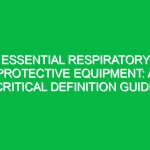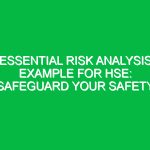Welcome and Introduction
Good morning, team! Today, we gather for our Toolbox Talk to discuss a crucial topic that directly affects our Safety and well-being at work: Rationalizing Unsafe Choices. This is an essential conversation because every day we face decisions that can either enhance our Safety or expose us to unnecessary risks. By understanding how we might justify unsafe actions, we can take proactive steps toward creating a safer work Environment.
What Are Unsafe Choices?
Before we delve deeper, let’s clarify what we mean by unsafe choices. These are decisions or actions that compromise safety Standards, whether due to negligence, lack of awareness, or the belief that shortcuts will save time. Examples include skipping the use of Personal Protective Equipment (PPE), ignoring safety protocols, or taking unnecessary risks because “nothing has happened before.”
The Psychology Behind Rationalizing Unsafe Choices
Rationalizing unsafe choices often stems from a psychological phenomenon where individuals justify their actions, even when they know they are not safe. This can include:
- Normalizing Risk: Believing that past experiences of safety make future risks negligible.
- Peer Influence: Feeling pressured by colleagues to take shortcuts.
- Time Constraints: Prioritizing speed over safety due to tight deadlines.
- Complacency: Becoming too comfortable with routine tasks and underestimating potential Hazards.
Understanding these psychological triggers is essential in addressing why we might make unsafe decisions and how to counteract them.
Real-Life Examples of Unsafe Choices
Let’s consider a couple of examples that may resonate with our daily operations:
- Example 1: A team member decides not to wear a hard hat while working on a construction site, reasoning that they are only moving equipment and won’t be near overhead work. This choice, although seemingly benign, can lead to severe injuries if something falls unexpectedly.
- Example 2: An employee skips a safety check before using a piece of machinery, thinking, “It worked fine last time.” This rationalization can result in equipment failure and possible injury.
These examples highlight the importance of recognizing and addressing our justifications for risky behaviors. We need to ensure that safety is a priority in all our actions.
Identifying Potential Hazards
In our work environment, we must be vigilant about recognizing hazards. Rationalizing unsafe choices often leads to overlooking potential risks. Here are some common hazards to watch for:
- Environmental Hazards: Slippery floors, poor lighting, or cluttered workspaces.
- Equipment Hazards: Faulty machinery, lack of Maintenance, or improper use of tools.
- Chemical Hazards: Inadequate handling of hazardous materials without proper PPE.
Each of these hazards can be amplified when we rationalize unsafe choices, emphasizing the need for a strong safety culture.
The Importance of Safety Protocols
Safety protocols are not just bureaucratic red tape; they are established guidelines designed to protect us. By adhering to these protocols, we can significantly reduce the risk of accidents. Here are some key protocols to remember:
- Use PPE: Always wear the appropriate Personal Protective Equipment for the task at hand.
- Follow Safety Procedures: Stick to established procedures, no matter how routine the task may seem.
- Report Hazards: If you see something unsafe, report it immediately. Don’t assume someone else will take care of it.
When we choose to follow these protocols, we actively counter the temptation to rationalize unsafe choices.
Best Practices for Avoiding Unsafe Choices
Now that we understand the psychological, environmental, and procedural aspects of safety, let’s discuss Best Practices for avoiding unsafe choices:
- Pause and Assess: Before starting any task, take a moment to assess the risks involved. Ask yourself if the task is safe and what Precautions you need to take.
- Communicate: Foster an open dialogue with your colleagues about safety concerns. Encourage team members to speak up if they notice unsafe behaviors.
- Continuous Training: Engage in ongoing safety training and refreshers. Knowledge is key in recognizing and mitigating risks.
- Embrace Accountability: Hold yourselves and your teammates accountable for safety. If you see someone making an unsafe choice, gently remind them of the risks involved.
These practices can help us cultivate a culture that prioritizes safety and minimizes the justification of unsafe actions.
Regulations and Standards
We also need to be aware of the Regulations and standards that govern our work environment. Compliance with these regulations is not merely a legal obligation; it is essential for our safety. Here are a few key regulations to keep in mind:
- Occupational Safety and Health Administration (OSHA): Sets and enforces standards to ensure safe and healthful working conditions.
- Environmental Protection Agency (EPA): Regulates hazardous waste and Environmental Safety standards.
- Company Policies: Familiarize yourself with our company’s specific health and safety policies, which align with these regulations.
Understanding these regulations helps us recognize the importance of our safety practices and the potential consequences of non-compliance.
Encouraging Open Discussion
Now, I’d like to open the floor for discussion. Let’s talk about instances where you’ve seen rationalizing unsafe choices occur. How did you handle it? What strategies can we implement to better address these situations?
Your experiences and insights are invaluable. Remember, we’re all in this together, and by sharing, we can learn from one another.
Conclusion
In conclusion, today we’ve explored the concept of Rationalizing Unsafe Choices and how it impacts our safety culture. By understanding the psychology behind these choices, recognizing potential hazards, and adhering to safety protocols, we can significantly reduce risks in our workplace. Remember to practice the Best Practices we discussed and prioritize safety in every task.
Thank you all for your attention and commitment to a safe working environment. Let’s make a concerted effort to think twice before making choices that could endanger us or our colleagues. Together, we can achieve HSE success!


